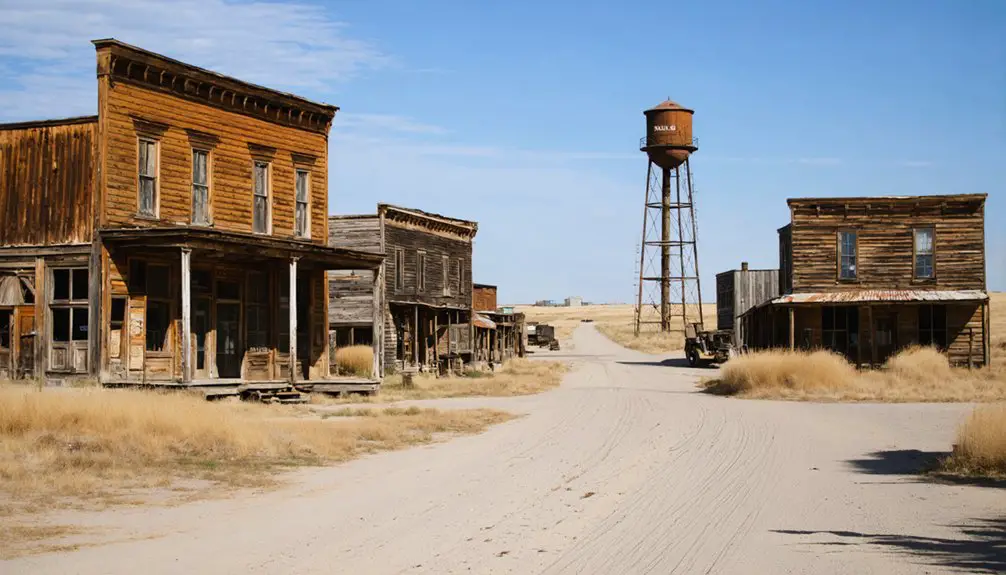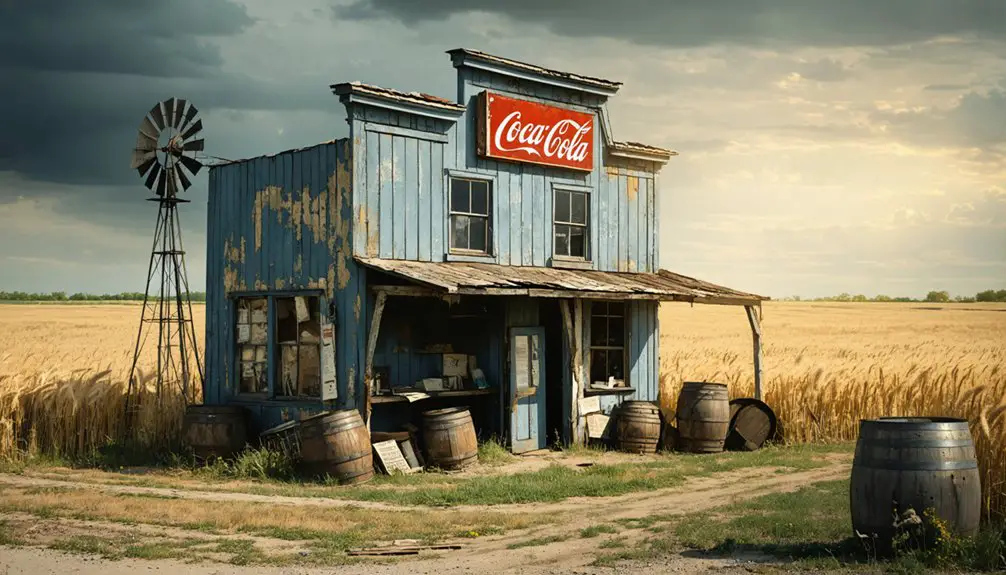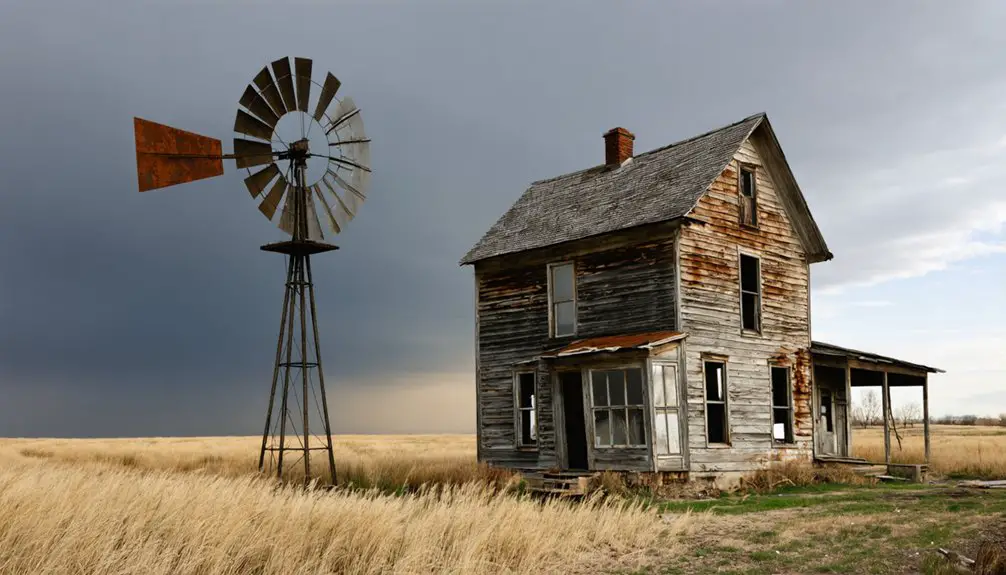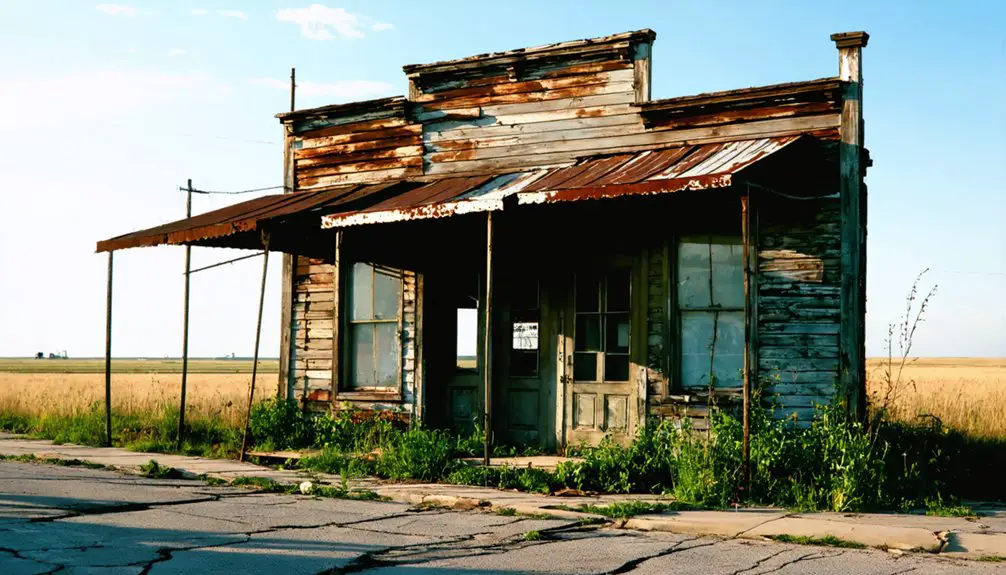You’ll find Belmont nestled near Crawford, Nebraska, where it began as a railroad camp in 1889 during the Belmont Tunnel construction. This Burlington Railroad boomtown peaked at 80 residents in the 1920s, thriving around its essential train depot and 698-foot tunnel through solid rock. After serving as a strategic point during WWI, Belmont declined through the Great Depression, with railroad service ending in 1982. Today’s ghost town preserves remarkable stories of America’s railroad heritage.
Key Takeaways
- Belmont began as a railroad town in 1889 near Crawford, Nebraska, during the construction of the Belmont Tunnel.
- The town reached its peak population of 80 residents in the 1920s before experiencing significant decline during the Great Depression.
- Passenger rail service ended in 1969, followed by complete railroad abandonment in 1982 when the Belmont Tunnel was converted to a service road.
- The Burlington Northern takeover in 1970 redirected resources away from Belmont, accelerating its transformation into a ghost town.
- Economic hardships, improved automobile access, and railroad service decline led to population exodus and business closures throughout the mid-1900s.
The Birth of Evergreen City
As the Chicago, Burlington and Quincy Railroad began constructing Nebraska’s only railroad tunnel in 1889, a small settlement called Evergreen City emerged near Crawford in Dawes County.
What started as a temporary encampment quickly transformed into a hub for railroad labor, providing essential support for the ambitious Belmont Tunnel project.
The town’s initial development was modest but purposeful. In 1890, surveyors mapped out the settlement, though only five blocks were sold at first. Just like other disambiguation pages, the name Belmont would later become associated with multiple locations and meanings.
The community reached its peak when eighty residents called the town home during the late 1920s.
You’ll find it interesting that while the town was built to serve the tunnel’s construction needs, it would later be renamed Belmont.
The settlement’s entire existence centered around the railroad’s expansion efforts, marking a significant chapter in Nebraska’s transportation history.
Engineering Marvel: The Belmont Tunnel
When the Chicago, Burlington and Quincy Railroad needed to cross Nebraska’s rugged canyon terrain in 1888, they undertook construction of what would become the state’s only railroad tunnel.
You’ll find this remarkable 698-750 foot passage carved directly through solid rock in western Dawes County, where tunnel construction crews worked tirelessly using only manual labor and 19th-century engineering techniques.
The Belmont Tunnel opened on August 25, 1889, serving rail traffic continuously until 1982.
For nearly a century, the Belmont Tunnel faithfully carried trains through Nebraska’s rugged landscape, from its 1889 opening until 1982.
During WWI, you’d have seen armed guards protecting this strategic passageway from potential sabotage.
The tunnel construction achieved remarkable progress with crews digging from both ends and making up to 6 feet per day.
The tunnel is located approximately 10-12 miles south of Crawford, Nebraska.
While trains no longer rumble through its carved walls, you can still visit this engineering marvel at 42°33′26″N 103°21′20″W.
Though marked by graffiti today, the tunnel’s structural integrity remains sound, converted into a service road that preserves its legacy.
Life in a Railroad Boomtown
Though originally known as Evergreen City, Belmont emerged as a quintessential railroad boomtown in the late 1800s, reaching its peak population of 80 residents by the 1920s.
The town’s railroad culture shaped every aspect of daily life, from work schedules to social gatherings. You’d find a tight-knit community of railroad workers and their families, demonstrating remarkable community resilience in the face of prairie isolation. The town’s only rail tunnel became a defining landmark of Belmont’s identity until its abandonment in 1982. The tunnel’s construction employed twelve hundred men, primarily Italian immigrants who endured harsh working conditions.
- Railroad workers filled essential roles as engineers, trackmen, and helpers for train climbs.
- Housing evolved from temporary shelters to permanent homes as the town established itself.
- Life revolved around train schedules, with the depot serving as the heart of community activity.
- Residents relied on each other for support, sharing resources and maintaining town infrastructure despite limited amenities.
Strategic Importance During World War I
During World War I, you’ll find that Belmont’s railroad tunnel required constant security monitoring, with armed guards posted at both entrances to protect this crucial transportation link.
You can picture the guards working rotating shifts to maintain 24-hour surveillance of the tunnel, checking identification papers and monitoring all rail traffic passing through.
The tunnel’s strategic importance meant that military personnel collaborated with local law enforcement to establish extensive security protocols, including regular patrols of the surrounding area and strict access controls.
This approach to securing vital infrastructure mirrored early Civil War tactics when Union troops regrouped under pressure to protect strategic positions.
Their vigilant defense strategy was reminiscent of how Medal of Honor recipients like Staff Sergeant Lucian Adams eliminated enemy threats to keep supply lines open in France.
Tunnel Guard Operations
As World War I intensified, the Belmont Tunnel emerged as an essential infrastructure asset requiring dedicated protection. Guard training emphasized vigilance at this important railway passage, where security personnel maintained round-the-clock surveillance techniques to protect against potential sabotage. The Nebraska National Guard maintained a constant presence to deter vandalism and threats.
You’d find these guards stationed near the tunnel’s entrance, monitoring all approaching traffic and suspicious activities. The Chicago Burlington Quincy railway’s significance made protecting this sole Nebraska tunnel a top priority.
Here’s what tunnel guards were responsible for:
- Maintaining 24-hour surveillance of the 698-foot tunnel and surrounding areas
- Coordinating with railroad staff and local law enforcement for rapid response
- Monitoring unauthorized access and potential tampering with tracks
- Serving as an early warning system for military and railroad authorities
These dedicated protectors guaranteed the tunnel’s continuous operation, supporting essential wartime supply lines and troop movements across western Nebraska.
Military Security Measures
While many Americans focused on coastal defense during World War I, Belmont’s strategic position in Nebraska proved fundamental to America’s inland security network.
You’ll find its location was essential for military preparedness, situated near major railroads that enabled rapid troop movements and supply distribution. The surrounding military installations, including 12 Army Air Fields, formed a robust homeland security system protecting crucial infrastructure and agricultural resources.
The area’s facilities trained thousands of personnel in modern warfare techniques, from chemical defense to tactical communications.
Security measures intensified to prevent sabotage of aircraft and munitions, while support squadrons maintained operational readiness.
Belmont’s position in Nebraska’s military ecosystem helped guarantee rapid mobilization capabilities and created a strong defense perimeter for America’s heartland during this significant period.
Peak Years and Population Growth

From its modest beginnings as a railroad work camp, Belmont achieved its peak population of approximately 80 residents in the late 1920s. The population dynamics were shaped primarily by railroad activities, particularly the Chicago, Burlington, and Quincy Railroad’s presence and the Belmont Tunnel construction.
Growth factors remained constrained by the town’s limited infrastructure and proximity to larger settlements.
Limited infrastructure and nearby larger towns kept Belmont’s growth potential in check throughout its existence.
Key aspects of Belmont’s peak years include:
- Only five blocks of the original town site were sold during the initial survey
- Most development centered around supporting railroad operations
- Local commerce stayed minimal due to competition from nearby towns
- Infrastructure primarily served railroad workers and surrounding agricultural communities
The town’s modest size and population reflected its specialized role as a railroad support community rather than a major commercial center.
The Great Depression’s Impact
During the Great Depression, Belmont’s economy collapsed as local businesses shuttered and farming families struggled with both financial hardship and severe drought conditions.
You’ll find that the town’s population, which had peaked at around 80 residents in the late 1920s, steadily declined as families were forced to seek employment and better living conditions elsewhere.
The Burlington Railroad’s diminishing activity through the Belmont Tunnel – once the town’s economic lifeline – combined with widespread unemployment to accelerate the community’s decline into a ghost town.
Economic Strain Hits Hard
As the Great Depression descended upon Dawes County in 1929, Belmont’s economic foundation began to crumble with the closure of a major Chadron bank, triggering widespread financial panic.
You’d have witnessed unprecedented economic hardship as the crisis deepened, with many residents losing their life savings and struggling to secure loans or mortgages.
The community’s resilience was tested as:
- Farm commodity prices plummeted, forcing farmers to expand acreage or switch crops.
- Nearly 10% of farms changed hands in 1933-34, half through forced sales.
- Local businesses faced closures as consumer spending dropped sharply.
- Unemployment in nearby Chadron reached about 10% of its 1930 population.
Despite community relief efforts and charitable initiatives, Belmont’s economy continued to deteriorate, with improved transportation allowing residents to bypass local businesses for larger markets.
Population Exodus Accelerates
While Belmont’s population had reached its peak of around 80 residents in the late 1920s, the onset of the Great Depression triggered a devastating exodus that would permanently alter the town’s trajectory.
Population trends show how the economic crisis intensified existing decline, as farm families faced collapsing crop prices and mounting debts. You’ll find that migration patterns shifted dramatically during this period, with younger residents particularly likely to seek opportunities elsewhere.
The social fabric of Belmont unraveled as families struggled with hunger and deprivation. Marriage rates fell, and birth rates declined, reflecting the severe demographic stress.
The town’s role as a local hub diminished further when improved automobile access allowed remaining residents to conduct business in larger towns, accelerating the population drain that would ultimately lead to Belmont’s ghost town status.
Railroad Activity Diminishes
The Great Depression struck a devastating blow to railroad activity near Belmont, triggering ripple effects that would permanently alter the town’s transportation landscape.
You’ll find that railroad decline accelerated as economic hardships drastically reduced both passenger and freight traffic through the region. Burlington Railroad’s eventual cessation of passenger services by 1969 reflected decades of diminishing returns.
- Freight reductions hit local commerce hard as farmers began using trucks instead of rail transport.
- The historic Belmont Tunnel lost strategic importance, leading to its bypass in 1982.
- Railroad companies shifted focus to heavy coal transport from Wyoming’s mines.
- Infrastructure investments moved away from small-town routes to more profitable mainlines.
The combination of improved road transport and Depression-era changes spelled the end of Belmont’s role as an essential rail hub.
Railroad Service Decline and Exodus
Following decades of railroad prosperity, Belmont’s fate took a dramatic turn when passenger service ceased in 1969, triggering a chain of events that would transform the bustling railway town into a ghost town.
The railroad decline intensified in 1981 when engineers reworked the route, abandoning the historic Belmont Tunnel and bypassing the town entirely.
You’ll find that this community isolation had devastating effects – businesses closed, the post office had already shuttered in 1956, and residents began moving away in search of better opportunities.
With the Burlington Northern takeover in 1970 shifting resources elsewhere and improved automotive transportation allowing people to shop in larger towns, Belmont’s population dwindled.
The town that once thrived with railway activity now stands as a reflection of changing transportation priorities.
Modern-Day Remnants and Historical Legacy
Modern-day visitors to Belmont encounter a landscape marked by scattered remnants of its railroad past, with Nebraska’s only railroad tunnel standing as the town’s most prominent surviving feature.
While the town’s population has long since departed, heritage preservation efforts have maintained this unique piece of railroad history as a tourist attraction, drawing history enthusiasts and adventurers alike.
You’ll find these notable elements at the site:
- The historic 750-foot Belmont Tunnel, built in 1888-1889
- Decaying stone walls and structural remnants along the tunnel path
- Historical plaques detailing the tunnel’s strategic importance during WWI
- Rural surroundings that offer glimpses into Nebraska’s railroad expansion era
Today, Belmont serves as an outdoor museum, preserving the story of early railroad development in Nebraska’s challenging terrain.
Frequently Asked Questions
Are There Any Ghost Stories or Paranormal Activities Reported in Belmont?
You won’t find documented haunting experiences or local legends in this area, as historical records and research show no reported paranormal activities or ghost stories associated with the location.
What Happened to the Original Buildings and Where Did Residents Relocate?
With a peak population of 80 in the 1920s, you’ll find most buildings either decayed or repurposed as farm homes. Residents gradually moved to larger towns like Crawford after services declined and the post office closed in 1935.
Can Visitors Access the Belmont Tunnel Site Today?
You’ll find the tunnel accessible via railroad access road, but you’re required to get landowner permission first. No official visitor regulations exist, though it’s recommended to explore cautiously given the remote location.
Were Any Notable Crimes or Accidents Recorded During Belmont’s Active Years?
Despite having 80 residents at its peak, you won’t find any documented crimes or unsolved mysteries in available records. Historical conflicts were limited to placing guards during WWI to prevent tunnel sabotage.
Did Native American Tribes Have Settlements Near Belmont Before Its Establishment?
You’ll find strong evidence of Native American settlements in this area, particularly from the Oto, Pawnee, and Arikara tribes, who established villages along the Platte River before European-American development began.
References
- https://en.wikipedia.org/wiki/Belmont
- https://www.onlyinyourstate.com/experiences/nebraska/belmont-tunnel-ne
- https://nebraskarules.tripod.com/id11.html
- https://kids.kiddle.co/Belmont
- https://history.nebraska.gov/wp-content/uploads/2017/12/doc_publications_NH1937GhostTowns.pdf
- https://www.houseofhighways.com/campspot/usa/midwest/nebraska/belmont
- https://mostateparks.com/sites/mostateparks/files/Belmont Hotel.pdf
- https://history.nebraska.gov/wp-content/uploads/2017/06/doc_collection_State_1915RR_Map.pdf
- https://www.trainorders.com/discussion/read.php?1,32256
- https://en.wikipedia.org/wiki/Belmont_Tunnel_(Nebraska)



